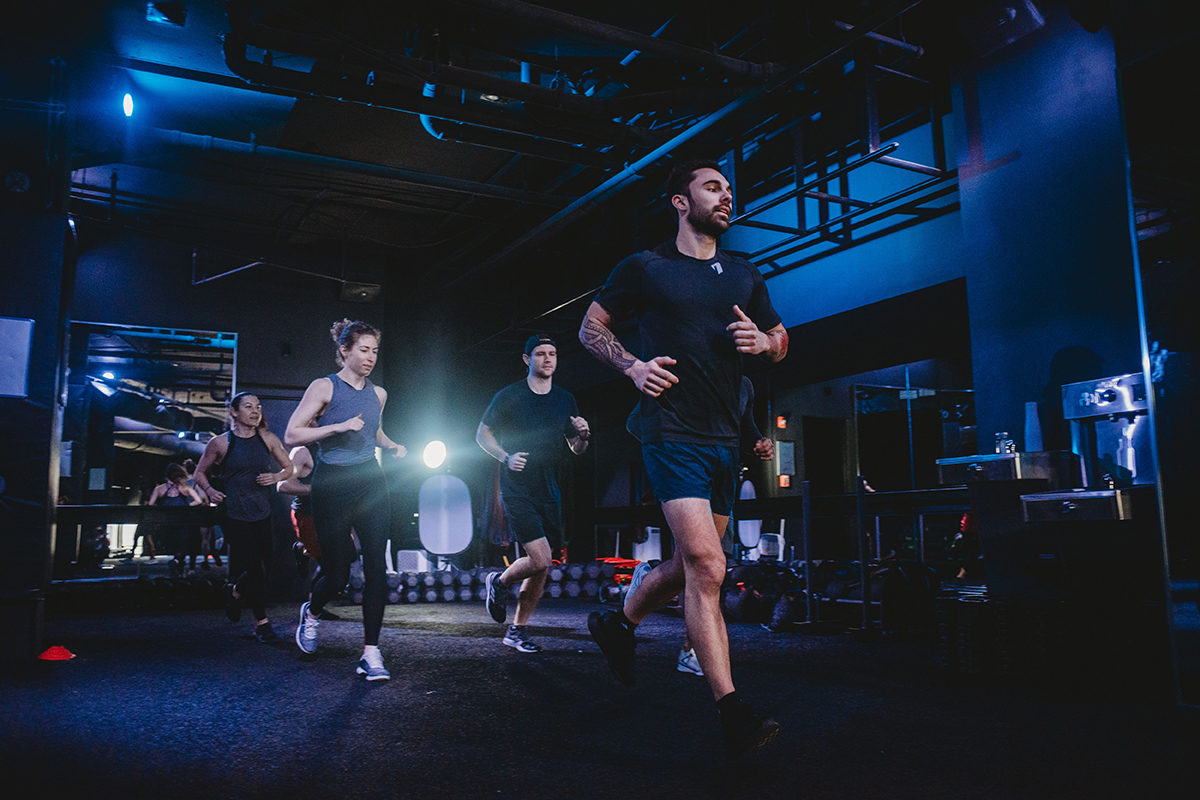How to Combine Cut Seven and Training for a Race

Each time you enter the studio, we expect you to get mentally stronger. Yes, we hope you pick up heavier weights or push the pace on the lane. But the mental toughness required to put yourself through Heart Day, then come back the very next week for another round, far outweighs any physical gains.
Which is why we expect you to challenge yourselves outside the studio. And why, when so many of you started signing up for marathons, Spartan races, and the Cherry Blossom 10-miler, we were very much unsurprised.
Even though a marathon takes four times as long as a Cut class, each of you is as—if not more—mentally prepared than any other runner on the starting line. This post is meant to address the physical aspects of training for a race, and how to balance Cut classes and running. But since the only running we do is limited to a 40-yard sprint, we decided to bring in an expert.
Julie Culley is the director of both the men’s and women’s track and field and cross-country programs at Georgetown University. Before her coaching career, she competed at the 2012 London Olympics in the 5k, and represented the United States at the world championships in the 3,000m, 5,000m, and 8,000m distances. She was kind enough to answer our questions on why strength training is imperative to racing, and how to balance strength exercises into your distance training.
Don’t Forget the Education You Learned Here: How to Maintain Proper Form

We don’t just train you to withstand a tough workout—we train you to understand the human body. It’s why we publish blog posts on different muscle groups and each of the six coaches is constantly up our asses if we give way to sloppy form. Our goal is to educate each of you so you can take the knowledge you learned here, and apply it outside the studio.
When you start training for a race, assess your form. Inside the studio, you know to keep your core engaged, shoulders rolled back and down, and chest out. These basic cues for proper form stay true whether you’re doing a goblet squat on the turf or logging miles on the pavement.
“We tell our athletes to ‘stand tall,’” says Culley. “This usually cues them to lengthen their spine, relax their shoulders, and reduce the sluggish stance that can cause the back to pitch forward and crowd the lungs.”
Sound familiar? How many times has a Cut coach instructed you to make those same adjustments (in similar words) inside the studio?
“When you’re running 26 miles, you’re not going to think about proper form,” says coach Katie, “Our goal is to establish a strong mind-muscle connection now, so it becomes second nature as you load on mileage.” Running “tall,” as Culley puts it, mitigates your chance of injury during marathon training and will likely improve your race time.
It’s Not Just About Mileage: Combining Strength, Endurance, and Interval Training
If your only race goal is to cross the finish line—whether it took 10 miles or 26.2 to get there—that’s great. But if your running logs include the exact same six mile route, at the exact same pace, week after week, with the only variance being your weekend long run, what does that say about your training?
Think about it this way: Would Chris or Katie ever program the same workout on back-to-back days (or even within the same month, for that matter)? No. They challenge us, and stress different energy systems, by adjusting our sets, reps, weight, and exercises.
With running, you can challenge yourself by running at different speeds, distances, and intensity. “Interval training is extremely beneficial at any race distance, from sprints, to the marathon, and beyond,” says Culley. “Working to build a more efficient aerobic and anaerobic system gives athletes the opportunity to make significant gains, and challenge new paces while racing.”
Aerobic training—which you get from steady state cardio—is only part of the equation. You need both anaerobic and aerobic to run a race. Anaerobic training, which you get from Cut Seven workouts and interval training, helps you to use oxygen more efficiently. This decreases the amount of oxygen you need to use when you settle into your race pace (aerobic), thereby improving your overall performance.
Even elite runners still lift weights—and at a higher frequency than you think. “Our athletes are in the weightroom three days a week, and a fourth day doing just a bodyweight circuit,” says Culley. “Two of our weight room days are ‘traditional’ lift days, while the third focuses on posture, movement patterns, and quick [explosive] movements.”
Why You Need Strength Training: Cut Exercises That Prevent Running Injuries

We understand there are only 24 hours in a given day. To train for a race you will, undoubtedly, need to decrease your frequency of Cut classes to make space for running (particularly long runs). That being said, eliminating strength training entirely only sets you up for injury. Elite runners still lift weights, and no, we’re not just talking core work.
“Strength training plays into the success of elite runners,” says Culley. “Balance exercises focus on the general strength of your core—which is absolutely necessary as your body breaks down over the thousands of steps needed in training—while more traditional lifts, like deadlifts, focus on power and posture.”
Different Cut moves provide all of the above, helping to keep you healthy through training. “I see dozens of different running injuries,” says physical therapist, Lauren O’Shea. “But most have the same cause: Glutes that don’t fire. This manifests in faulty movement patterns, causing you to injure your knees, ankles, or hips while running.”
To prevent this from happening, Lauren has two tips: First, never skip Ass Day; and second, focus heavily on single leg movements.
“Think about it—when you run, you’re basically always in a single leg squat position,” says Lauren. “If you can’t balance on one leg in a controlled environment like Cut, you won’t be able to do so while running down the street.”
Katie backed up Lauren’s advice entirely, saying you should never skip Leg Day, unless it falls directly before your long runs. While you may erroneously think you get in enough leg work by logging miles, exercises like Bulgarians, single leg squats, single leg deadlifts, and other Cut moves done on Leg Day keep you healthy for the duration of your training.
The Number One Missing Piece from Your Training: Rest and Recovery

Point blank, we asked Julie the number one mistake people make when training for a marathon, and this is what she told us: Overtraining, undertraining, and not listening to their body when something doesn’t feel right.
“Rest and recovery are a massive part of the training formula,” she says, “If your body isn’t recovering properly, it will lead to fatigue, sickness, and injury. When athletes are afraid to admit that they are getting injured or something is more sore or tight than before, we run the risk of having to take large chunks of time off as opposed to a few days. [It’s about] Smarter training—not tougher training.”
Chris tells us, “For weekend warriors and other non-elite runners, the only way to win a marathon is to walk away without injury.” We told you before, and we’ll tell you again: We don’t want to see you if you’re sick, hurt, or burnt out. In fact, if your body is breaking down, the only teammate you should be seeing is Lauren. Pushing through an injury will not get you to the finish line. Find out what’s wrong before you’re forced to give up running entirely.
We wrote this article as an educational piece for all of you. But please understand 1,500 words is not enough to guide you through four-plus-months of training. Ask questions to your coaches after class, speak to a physical therapist, but most importantly listen to your body and make adjustments as needed.
And to all of our teammates racing through the spring and summer months, good luck.